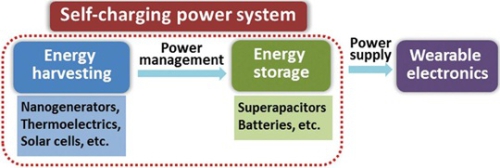
Self-charging energy system diagram
In recent years, portable wearable electronic devices have been used on a large scale and have been developed toward miniaturization, intelligence, multi-functionality, and flexibility. However, the main problem faced by wearable electronic products is that existing batteries are not sufficient for their continuous power supply, and frequent charging and battery replacement limit their further development. To solve this problem, in addition to increasing the energy density of energy storage cells, another feasible solution is to integrate the energy conversion and storage device into a self-charging power system (SCPS), which enables the collected energy. It can be stored in real time and achieve sustainable power supply. This program has recently attracted widespread attention and in-depth research in the academic community. Researchers have successfully developed a variety of energy harvesting devices, including frictional nanogenerators (TENG), piezoelectric nanogenerators (PENG), solar cells, and thermoelectric generators. These energy harvesting devices and energy storage devices (batteries, The combination of supercapacitors is further integrated in flexible, wearable electronic devices that compensate for the energy consumption of electronic devices in real time and even achieve energy self-sufficiency.
Recently, researchers at the Beijing Institute of Nano Energy and Systems, Chinese Academy of Sciences, Pu Xiong and Hu Weiguo, and Academician Wang Zhonglin from the Chinese Academy of Sciences, have summarized the development of the rechargeable energy system and outlined various self-charging energy systems (including integrated TENG, PENG, and solar energy) that have been reported. Energy conversion devices such as batteries, thermoelectric devices, and systems for energy storage devices such as batteries and capacitors). Discuss how these systems integrate at different levels of materials, electrodes, and devices, and focus on the self-charging of wearable flexible electronic devices. Integrated system. The paper discusses the importance of power management systems in self-charging energy systems and the current progress.
In addition, the paper summarizes the progress and problems faced in this field. Significant progress: Prototypes of multiple energy integration systems such as those based on PENG, TENG, and solar cells; SCPS for different energy sources each have their unique advantages; SCPS has many potential applications such as flexible/wearable electronic devices, personal healthcare Health care, sports monitoring, self-powered sensors, internet of things, etc. Main issues: Most SCPS are still in the proof of concept phase; the efficiency of each integrated unit in SCPS is low; the overall system efficiency of SCPS needs to be improved; selection of applicable energy storage battery or capacitor system is crucial; the mechanism of several SCPS is not yet complete clear.
The relevant research work was published in small.
Kylin Chemicals manfacturers & supplies high performance flocation flocculants & collectors, serving the various mining industries like coal, phosphorous, copper, lead, nickle, gold, silver, potassium & sand-washing, etc. Our advanced manufacturing facilities and effective quality control systems, ensures every delivery of goods fully meets/exceeds our customers` end using needs. Today, our flocation flocculants & collectors have been widely accepted by various mining industries in Southeast Asia, Middle East and Latin America.


Flotation Flocculants & Collectors
Flotation Flocculants & Collectors,Potassium Amyl Xanthate,90% Potassium Amyl Xanthate,Industrial Potassium Amyl Xanthate
Kylin Chemicals Co., Ltd. , http://www.kylin-chemicals.com